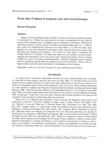Weedy Rice Problems in Southeast Asia and Control Strategy
JIRCAS international symposium series
| ISSN | 13406108 |
|---|---|
| NII recode ID (NCID) | AA1100908X |

Full text
intlsymp-4_27-37.pdf441.23 KB
Weedy rice with undesirable traits can inflict crop loss by reducing the yield and quality of commercial rice. Weedy rice rarely grows in the case of transplanted rice, but with the spread of direct seeding culture in Southeast Asia, its infestation is increasing. Difficulties in controlling volunteer rice have allowed the fields to be infested with weedy rice. In this region, weedy rice originated from cultivated rice (Oryza sativa L.) or wild rice (other Oryza species), and could have developed its ecological weedy characteristics such as easy grain shattering and moderate seed dormancy. It is known as "Padi angina" in Malaysia and "Weedy wild rice" in Thailand. It is likely that weedy rice will continue to evolve morphologically and metabolically as the rice crop by inter-crossing with modern cultivars, making it difficult to control it by using available herbicides. Therefore, integrated control measures based on ecological methods should be applied to overcome the problems. Genetic and ecological studies would give useful information for developing a control strategy.
| Creator | Hiroaki Watanabe |
|---|---|
| Subject | weedy rice wild rice volunteer rice easy shattering seed dormancy |
| Publisher | Japan International Research Center for Agricultural Sciences |
| Available Online | |
| Issue | 4 |
| spage | 27 |
| epage | 37 |
| Language | eng |
